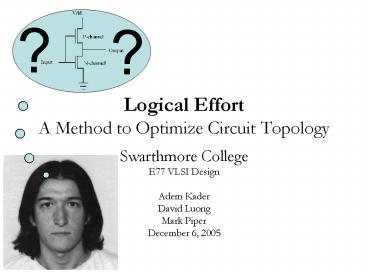Logical Effort A Method to Optimize Circuit Topology - PowerPoint PPT Presentation
1 / 24
Title:
Logical Effort A Method to Optimize Circuit Topology
Description:
Logical Effort A Method to Optimize Circuit Topology Swarthmore College E77 VLSI Design Adem Kader David Luong Mark Piper December 6, 2005 Current Issues Facing ... – PowerPoint PPT presentation
Number of Views:76
Avg rating:3.0/5.0
Title: Logical Effort A Method to Optimize Circuit Topology
1
Logical EffortA Method to Optimize Circuit
Topology
- Swarthmore College
- E77 VLSI Design
- Adem Kader
- David Luong
- Mark Piper
- December 6, 2005
2
Current Issues Facing Circuit Designers
- Wanting to optimize circuits for faster
performance, inexperienced designers often
encounter - Simulate-and-Tweak loops
- Incomplete intuition in design process
- Uncertainty in decision-making
3
Logical Effort as a Solution
- Quick method of circuit analysis
- Circuit topology
- Transistor sizing
- Delay estimation
- Easy way to compare multi-stage designs
- Back-of-the-envelope calculation
- Provides intuition of circuit timing
characteristics in complex circuitry
4
How does it work?
- Assumes RC model of a transistor
- d gh p
- d propagation delay
- gh effort delay
- g logical effort
- h electrical effort Cout/Cin
- p parasitic delay
5
Defining Logical Effort
- Ratio of the input capacitance of the gate to the
input capacitance of an inverter that can deliver
the same output current - Measure of a gate to drive a particular fan-out
relative to an inverter
6
Visualizing Logical Effort
7
Application of Logical EffortEstimating Delay
Propagation
INVERTER
d g h p
NAND
8
Multi-Stage Design and Logical Effort
- Often circuits are more complicated than an
inverter or a NAND gate - Same framework applies with the modification
9
Logical Effort and Transistor Sizing
- Interested in choosing transistor sizing to
minimize stage and overall delay - f (min) g(i) h(i) F1/N
- Delay equation becomes
- In the end
10
Application of Transistor Sizing
How do we choose stage capacitances given we want
to minimize propagation delay?
11
Optimal Number of Gates
Path Effort F Optimal N Minimum Delay, D Stage Effort, f
0-5.83 1 1.0-6.8 0-5.8
5.82-22.3 2 6.8-11.4 2.4-4.7
22.3-82.2 3 11.4-16.0 2.8-4.4
82.2-300 4 16.0-20.7 3.0-4.2
300-1090 5 20.7-25.3 3.1-4.1
1090-3920 6 25.3-29.8 3.2-4.0
Rule of thumb is
Note that single gate does not always translate
to minimized delay
12
Example The Implementation Problem
Which do you choose?
13
Using Logical Effort
- Option 1
- Path logic effort G 1 6/3 1 2
- Path Branch Effort B 1
- Path electrical effort H Cout/Cin 8C/C 8
- Path Stage effort F GBH 218 16
- Dmin NF1/NP 3(16)1/3 (141 1)
33.25 6 13.5
14
Using Logical Effort
- Option 2
- Path logic effort G 1 4/3 5/3 20/9
- Path Branch Effort B 1
- Path electrical effort H Cout/Cin 8C/C 8
- Path Stage effort F GBH 20/918 160/9
- Dmin NF1/NP 3(160/9)1/3 (121 2)
33.25 5 12.8
15
Using SPICE
16
Example Choosing the Optimal NThe Buffer Problem
- Must drive 64 parallel inverters
- Choose 1, 3, or 5 series inverter stages to drive
the load?
17
finding optimal of stages
N 5 3 1
f 2.3 4 64
D 16.5 15 65
18
1 inverter
19
3 inverters
20
5 inverters
21
all together
22
Problems with logical effort
- Its only an approximation
- But a good one
- It does not guarantee optimal solution
- but gets quite close
- Chicken and egg problem
- chicken
- Built for speed
- Does not account for power consumption and
physical size
23
So What Have We Learned?
- Logical Effort
- Provides method to quickly determine speed of
design topologies for comparison - Displays changes to parameter tweaking
24
Its so logical!
I agree with stupid ?
now that makes sense!































